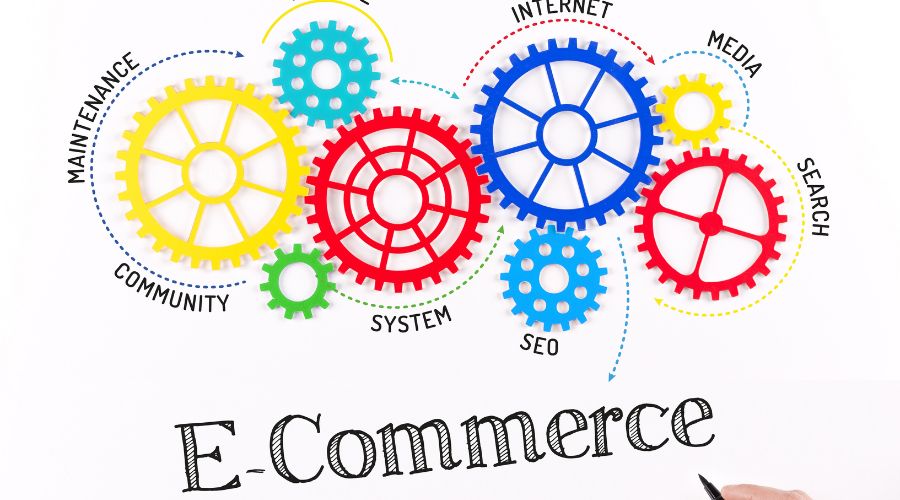In today’s world, online shopping is the norm. For businesses to thrive, using e-commerce SEO is key. But, have you thought about what are the best e-commerce SEO strategies to boost your online store’s traffic and sales?
This guide will show you how to make your online store more visible. We’ll talk about improving user experience and driving more sales through smart e-commerce SEO. We’ll cover everything from SEO audits to optimizing product pages and site architecture. You’ll learn how to stay ahead in the Australian e-commerce market.
Key Takeaways
- Discover the importance of e-commerce SEO in driving organic traffic and sales.
- Understand the benefits of implementing effective e-commerce SEO strategies.
- Learn how to conduct keyword research and optimize product pages for better search visibility.
- Explore technical SEO best practices to improve site speed, mobile-friendliness, and overall user experience.
- Gain insights into the growing significance of e-commerce SEO in the Australian e-commerce landscape.
Let’s start a journey to unlock your e-commerce’s full potential with strategic SEO. Together, we’ll take your online store to new success levels!

The Importance of E-commerce SEO
E-commerce businesses in Australia are booming, and SEO is key. Search engines bring in 53% of their traffic. By optimizing your online store, you can open up many opportunities and enjoy SEO’s benefits.
Search Engine Optimization as a Low-Hanging Fruit for E-commerce Websites
SEO offers a great ROI, but many e-commerce sites in Australia ignore it. They often choose social media or paid ads instead. These methods need constant effort and money. SEO, however, needs effort only once, and then you can make sales easily without spending more.
The Benefits of SEO for E-commerce Businesses
- Increased organic traffic: SEO boosts your site’s visibility, attracting more visitors.
- Higher conversion rates: Sites that rank high get more clicks from the right customers, leading to more sales.
- Improved customer engagement: Optimized e-commerce sites engage customers better, building loyalty.
- Cost-effective marketing: SEO brings organic traffic, saving money compared to paid ads.
- Sustainable growth: Long-term SEO investment leads to ongoing growth in visits, conversions, and content.
By learning and applying best practices for e-commerce SEO, Australian businesses can grow their online stores. This leads to more sales and better ROI from marketing efforts.
On-Page SEO Strategies for E-commerce
Improving your e-commerce site’s search engine ranking is key to more visitors and sales. A good on-page SEO strategy starts with smart keyword research and optimizing product and category pages. By following best practices, you can increase your chances of showing up in important search engine results and attracting the right customers.
Keyword Research for E-commerce Sites
Keyword research is the base of a strong e-commerce SEO plan. You need to find keywords with good search volume and buyer intent. Use tools like Google Keyword Planner, Amazon Keyword Tool, and analyze competitors to find the best keywords for your business.
Optimizing Product and Category Pages
After finding the right keywords, it’s time to optimize your pages. Use your target keywords in the URL, title tag, body content, and image alt text. Make sure your content is engaging, informative, and meets user needs. Also, using structured data and rich snippets can help you stand out in search results.
| Best Practices for E-commerce On-Page SEO | Potential Benefits |
|---|---|
| Conducting comprehensive keyword research | Identifying the most relevant and high-converting keywords |
| Optimizing product and category pages | Improving search engine visibility and attracting qualified traffic |
| Implementing structured data and rich snippets | Enhancing SERP features and click-through rates |
| Creating high-quality, user-focused content | Establishing authority and trust with search engines and customers |
By using these on-page SEO strategies, e-commerce businesses can improve their online presence. This leads to more qualified visitors, higher sales, and increased revenue. The secret to success is ongoing optimization and focusing on delivering value to your customers.
The Role of Content Marketing in E-commerce SEO
Content marketing is key in the ever-changing e-commerce world. It helps boost organic traffic and build domain authority. By making and sharing valuable content, we reach more people than just our product pages.
Studies show that using a Starter Growth Service can lead to a 242% increase in organic traffic in 12 months. Also, 70% of online marketers find SEO more effective than pay-per-click ads for sales.
Content marketing includes many types, like blog posts, videos, images, and infographics. By creating content that solves our audience’s problems, we improve SEO and gain trust.
It also helps with backlinks and domain authority. High-quality content, like industry reports, can attract links from trusted sites.
As we improve our content strategy, finding the right mix is crucial. We need Awareness Content for a wide audience and Sales Centric Content for conversions. By tracking our content’s success and making smart changes, we can grow our e-commerce business.
Technical SEO Clean-Up for E-commerce Sites
As e-commerce owners, we know how important technical SEO is. It helps our online stores be seen more and work better. But, it’s not just about keywords and content. The technical side of SEO can really affect our rankings.
Let’s look at the main technical SEO areas we need to focus on. These will help improve our e-commerce site’s search engine performance.
Optimizing Website Architecture for Search Engines
The way our site is set up is key for search engines to find and list our pages. We need to make sure our site is easy for users to navigate. At the same time, it should be good for search engines too.
This means having a clear category and subcategory system. We should also use internal links wisely and keep our navigation simple and logical.
Improving Page Speed for Better User Experience
Page speed is very important today. It affects how users feel about our site and how search engines rank us. Slow sites can lose a lot of money and users.
To fix this, we should make our images smaller, reduce CSS and JavaScript files, and use caching. This will make our site load faster and feel smoother to users.
Managing Redirects to Minimize SEO Impact
Handling redirects well is key for our site’s SEO. When we change our site, we need to make sure we don’t lose our search ranking. We do this by setting up the right redirects.
By linking the old and new URLs smoothly, we can keep our site’s ranking and traffic. This helps our e-commerce site stay strong online.
| Technical SEO Best Practices | Benefits |
|---|---|
| Optimizing website architecture | Improved crawlability and indexation by search engines |
| Enhancing page speed | Enhanced user experience and higher conversion rates |
| Implementing effective redirects | Preserving search engine ranking and organic traffic |
By focusing on these technical SEO areas, we can make our e-commerce site better for both search engines and our customers. This will bring more quality traffic and increase our online sales.
E-commerce SEO in the Australian Landscape
The Australian e-commerce market is growing fast, with sales expected to jump by 37% from 2024 to 2028 (Statista). For small businesses, a good e-commerce SEO plan can make a big difference. It helps them get noticed online and attract more customers.
The Growing Importance of E-commerce SEO in Australia
As the e-commerce scene in Australia gets bigger, small businesses need to focus on SEO. They should do keyword research to make their websites better for search engines. This means more people will find their online stores.
Using long-tail keywords, which are longer phrases, can help a lot. They show people are ready to buy. Making product pages better, with the right keywords and images, can also draw in new customers.
“Incorporating vibrant images, using keywords naturally, highlighting key features, and maintaining a conversational tone can help enhance product pages for e-commerce SEO.”
Websites that are easy to use and navigate can lead to more sales. Good content, like blogs and videos, keeps customers interested and builds trust in the brand.

Keyword Research for E-commerce SEO
As e-commerce business owners, we know keyword research is key to SEO success. It helps us understand what our customers are looking for. This way, we can make sure our content and products meet their needs.
In the competitive online retail world, this is crucial. It helps drive targeted traffic and turn visitors into loyal customers.
Determining Keyword Intent for E-commerce Sites
The first step in keyword research is figuring out the intent behind the keywords. Are people looking for info (informational keywords) or ready to buy (commercial keywords)?
By looking at search engine results pages (SERPs), we can understand the user’s mindset. Then, we can tailor our content and product pages to match.
The Significance of Long-Tail Keywords
While broad keywords might seem appealing, long-tail keywords are very valuable for e-commerce. They’re specific and have lower competition, making it easier to rank for them.
Long-tail keywords also have higher purchase intent, leading to more conversions and sales. In fact, long-tail keywords make up 70% of all web searches.
| Keyword | Search Volume | Keyword Difficulty | Search Intent |
|---|---|---|---|
| pet supplies | 74,000 | 60 | Informational |
| best dog food for small breeds | 1,900 | 30 | Commercial |
| organic cat litter for sensitive cats | 590 | 20 | Commercial |
By doing thorough keyword research, we can create a solid e-commerce SEO strategy. This strategy drives real results for our business.
Product Page Optimization for E-commerce SEO
In the fast-changing world of e-commerce, making your product pages stand out is key. This is a crucial part of a good SEO plan. By making your product pages more visible and appealing, you can grab the attention of potential buyers.
Enhancing Product Pages for Better Search Visibility
Using the right keywords is a big part of making product pages better. Adding relevant keywords to your descriptions, titles, and meta tags helps your pages show up higher in search results. This makes them easier for your target audience to find.
The look of your product pages is also very important. Making your images better with good file names and alt text helps with search visibility. It also makes your site more user-friendly, building trust with your customers.
Adding positive customer reviews to your product pages is a great marketing move. Reviews give social proof and fresh content for search engines. This boosts your online presence.
Writing in a friendly and engaging way in your product descriptions helps connect with your audience. Finding the right mix of informative content and a personal touch guides customers through their buying journey. This can lead to more sales.
By using smart keywords, eye-catching images, customer reviews, and a friendly tone, you can make product pages that rank well and engage your audience. This can lead to more sales.
E-commerce SEO: Boost Your Online Store
For e-commerce businesses, using search engine optimization (SEO) can change the game. There are more strategies to help your online store get seen more and sell more. This is key in the competitive world of e-commerce.
It’s vital to make sure your site works well on mobile devices. Over 60% of searches are now on phones and tablets. A site that looks great on these devices is crucial for keeping your rankings up.
Setting up a strong internal linking system is also smart. It helps search engines find and index your content better. This makes your site more visible and easier to navigate.
Don’t forget to optimize your product images. Good images make your site look better and can help you show up in image searches. This brings more people to your site.
Speeding up your site is also very important. Slow sites can lose 79% of shoppers. A fast site keeps users happy and helps your rankings.
Creating interactive content like demos or quizzes can really engage your audience. It also tells search engines your site is valuable. This can help your site rank better.
Finally, don’t overlook the value of link-building and customer reviews. Good links from other sites make your site look more trustworthy. Positive reviews can also make people more likely to buy from you.
By using these e-commerce SEO tips, you can make your online store more visible. This brings more people to your site, leading to more sales and more money.
Conclusion
Effective e-commerce SEO is key for businesses wanting to succeed in Australia’s online market. By using the best practices from this guide, your online store can get more visibility and sales. This includes doing SEO audits, keyword research, optimizing product pages, and improving site architecture.
SEO is a long-term investment that gives e-commerce businesses a big edge. It helps attract the right customers, boosts organic traffic, and improves user engagement and sales. The benefits of a good e-commerce SEO strategy are clear.
If you’re starting your e-commerce journey or want to grow your online store, use these SEO tips. Doing so will help you unlock your e-commerce business’s full potential. You’ll be on the path to sustained growth in Australia’s online world.
FAQ
What is the importance of e-commerce SEO?
E-commerce SEO is a great way for online stores to grow. It boosts visibility and drives more traffic. This means more sales with less cost over time.
What are the key on-page SEO strategies for e-commerce sites?
Important strategies include finding the right keywords and using them in your site’s content. This includes the URL, title tags, and image alt text. Also, using content marketing helps rank for specific keywords.
How can businesses optimize their e-commerce website architecture for search engines?
To optimize your site, make sure it’s easy to navigate. Use clear categories and product pages. Also, keep your site fast and manage redirects well to keep your SEO strong.
What is the significance of keyword research for e-commerce SEO?
Keyword research is key to a good SEO plan. It helps you understand what customers are looking for. You want to target keywords that are searched often and easy to rank for.
How can e-commerce businesses optimize their product pages for better search visibility?
To improve product pages, use keywords in descriptions and optimize images. Include customer reviews and write in a friendly tone. This helps engage potential buyers.
What other important e-commerce SEO tips should businesses consider?
Other tips include making your site mobile-friendly and using internal links. Optimize images and improve site speed. Create interactive content and focus on quality link-building. Also, highlight positive customer feedback.




